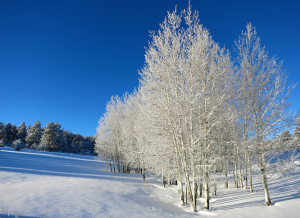by Peter Anderson
Wolves had never been a presence in my life. I had never lived around them, so I didn’t know much about their biology or natural history. Then, early on a November morning about 10 years ago, a chance encounter here in the Sangre de Cristos changed that. I have never talked much about the experience only because the biological details were so sketchy. I’ll explain that later. First, here are some facts about wolves in Colorado, most of which were gleaned from Division of Wildlife publications. (Note: Just because it’s in a government document doesn’t mean it’s true, but most of these events are well documented and not at all controversial.)
From “Guidelines for Response to Gray Wolf Reports in Colorado, Colorado Division of Wildlife, January 2005,” a report that was issued to advise wildlife officers on possible wolf sightings in Colorado, there is this statement: “It is likely that gray wolves, particularly single, young adults, may wander from wolf populations either north or south of Colorado into our State.” In March of 2005, a wolf that migrated south from Yellowstone was found dead on Interstate 70 about five miles west of Idaho Springs. It was the first “wild” wolf seen in Colorado since 1935. (Another DOW document says the last Colorado wolf was killed in 1943, so I’m not sure which is true.)
In 2009, another wolf from Yellowstone was found dead in Eagle County. According to the data from her GPS collar, this lone female traveled through five states, covering over a hundred miles after leaving her Montana home in September of 2008. After traversing Yellowstone National Park, the Bridger-Teton National Forest, western Wyoming, southeastern Idaho and northeastern Utah, she arrived in Eagle County in February of 2009. Her bones were discovered in March of 2009. Circumstances of death: uncertain.
Since then, in that same region of western Colorado, on the 300-square-mile High Lonesome Ranch up in the Piceance Basin near the Book Cliffs, biologists have found signs – mostly scat – that suggest some wolves may be settling in to stay. While they agree that wolves could find suitable habitat in Colorado, they acknowledge that it is fragmented. In an article that appeared in the High Country News (February 2010), wildlife biologist Carlos Carroll, who has done several studies of potential wolf habitat in the state, says that “a wolf population would depend largely on three distinct swaths of public land in western Colorado – one in the San Juan Mountains of southwestern Colorado, one southwest of Aspen, and one in the Flattop Mountains, just northeast of the High Lonesome Ranch.”
[InContentAdTwo]
Now back to the Division of Wildlife document that I mentioned earlier. “Due to topography, vegetation and distances from existing populations,” it says, “certain areas of Colorado have a greater chance of wild wolf occurrence. In southern Colorado these include areas west of Hwy. 285 and south of Hwy. 50, with portions of Montezuma, La Plata, Archuleta, Conejos, Dolores, San Juan, Hinsdale, Mineral or Rio Grande Counties most probable.” Notice that this list of more likely places for wild wolf sightings does not include Saguache County, or for that matter the Sangre de Cristos. Even though counties like Rio Grande and Mineral over in the San Juans aren’t that far away, one wouldn’t expect a wayward wolf to end up over here, but neither would you expect to find one on I-70.
Anyhow, I saw something one November morning about ten years ago that I still cannot explain. I had gotten an early start, just before daybreak, and drove up the North Crestone Creek trailhead. No one else was parked there. An early snow had fallen. It was wicked cold. But I had vowed to log in some good mountain miles before a Thanksgiving Day feast. Wearing just about every warm layer I had, I began walking up the mountain into an icy breeze. As I made my way up the switchbacks and broke out of the trees, I was warming up and hitting my stride, and I figured I had enough time to take another trail north toward Ground Hog Basin. Coming out of a creekside swale, I heard a sound that I would describe as a high moaning howl. I stopped. And listened. And then I heard it again, so I walked up around a clump of spruce and the trail opened out into a high meadow. There, maybe 100 feet up the trail, was an animal of the canine clan. Like I said, my knowledge of wolf biology was limited. I couldn’t unequivocally identify this animal, but it didn’t appear to be a dog and it was too big to be coyote. Not to mention that unusual howl.
I didn’t try to get any closer. The animal looked over my way. Its eyes were not especially orange or yellow as one might find in a wolf or a wolf-hybrid, but neither were they the blues eyes one might see in a domestic dog. After a fairly long encounter – maybe standoff is a better word – I turned away and started back down the mountain, unsure of what I was leaving behind, but certain that it was something I had never seen or heard before.

